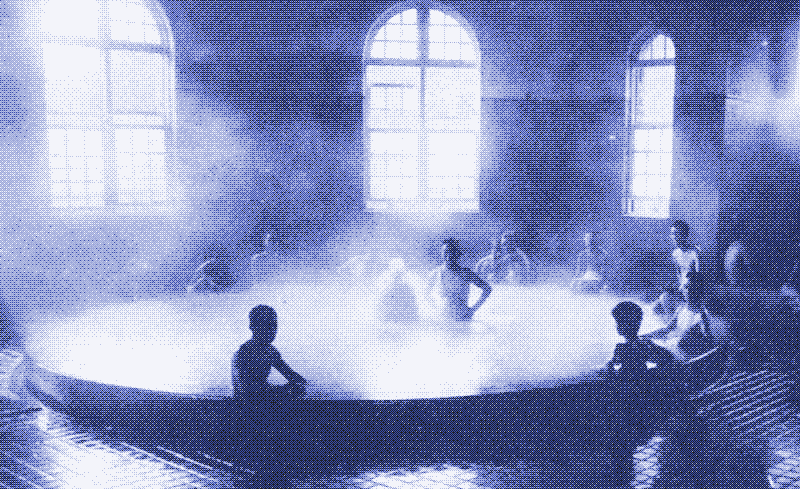
No Running Water at Home
For people in industrial societies, few activities demand more privacy than washing and grooming the body. We usually do it alone, in our private bathrooms, with locked doors. Seen in a historical context, that is unusual. Bathing in the presence of others has been the rule rather than the exception. As late as the first half of the twentieth century, many households, even in the most advanced industrial societies, did not have running water at home, let alone a private bathroom. 1
A bathroom requires a domestic water supply, but also a sewer drain, and an energy source to heat the water. Of course, it’s possible to have a hot bath at home without these infrastructures. Ever since Antiquity, the rich have built private baths in their houses. Most often, they could do that because less well-off people - either servants or slaves - filled and emptied their bathtubs with bucketloads of water and collected firewood to heat them.
However, for most people, it was more practical to take their bodies to the water rather than the other way around. For some, that meant bathing in rivers, lakes, and springs. For others, especially in urban environments, it meant visiting the public bathhouse.
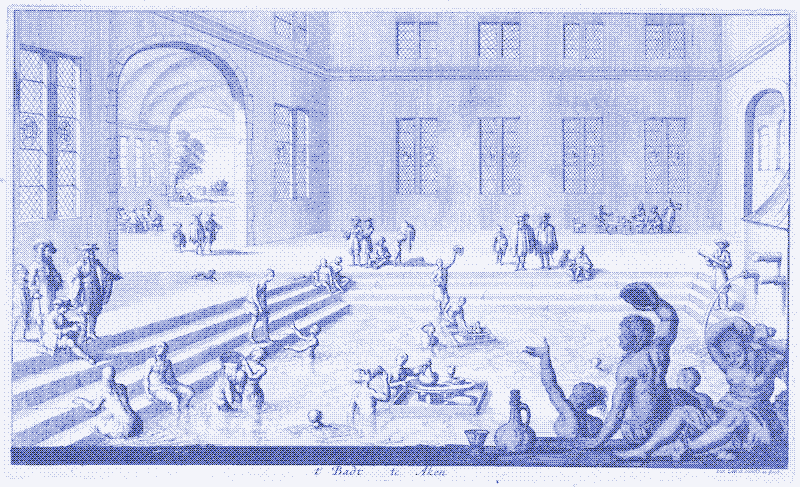
Is Bathing Unsustainable?
Modern bathing practices are a textbook example of an unsustainable lifestyle based on fossil fuels. Hot water production is the second largest energy use in many homes (after space heating and/or cooling), and much of it is used for bathing or showering. 2 The modern bathroom also uses a lot of water and adds extra energy use through space heating and waste-water treatment. Building and renovating bathrooms requires resources, too.
Sustainability advocates follow two strategies to address these problems. The first strategy concentrates on technological solutions, such as low-flow showerheads, water boilers heated by solar collectors, waste-water heat recovery systems, and greywater recycling. The second strategy counts on behavioral or social changes by questioning modern standards of cleanliness and comfort: bathing or showering shorter and less frequently, taking cold showers, or doing a cat wash at the sink. 23
These strategies are unlikely to bring much results. Many technological fixes are difficult or impossible to install in existing buildings, especially in cities. For example, as the number of floors increases, an apartment building quickly runs out of roof space to install solar collectors for all residents. On the other hand, promoting discomfort as a sacrifice for sustainability is unlikely to engage broader environmental practices. 34
Communal bathing makes it easier to disconnect bathing practices from fossil fuels.
Communal bathing could be a third approach, but it’s rarely mentioned. That’s remarkable because, in terms of resource efficiency, it’s hard to beat. Building and operating a bathhouse for 1,000 people requires much less energy than building and operating 1,000 individual bathrooms. A public bathhouse is also more efficient concerning materials, money, and space. 5
Just as importantly, public bathing makes applying the sustainable technologies mentioned above more feasible. That further reduces energy consumption and makes it possible to disconnect bathing practices from fossil fuels. Finally, a public bathhouse can achieve significantly improved sustainability without promoting discomfort. On the contrary, pooling resources to build something for a community rather than for every household separately allows for a high level of sustainable extravagance. That may be an easier sell than cold showers.

Bathing in Rivers, Lakes, and Hot Springs
Nature has provided humans with bathing facilities through streams, rivers, pools, lakes, waterfalls, and rain showers. Humanity spent much time in tropical Africa, where bathing did not require artificially heated water for comfort. When we moved into colder climates, Nature presented us with another solution: hot springs. Many tens of thousands of thermal springs exist around the planet — only a few present-day countries lack them entirely. 67
Bathing in hot springs was common in ancient civilizations all over the world. However, it’s a practice that goes back even further in time. Archeological evidence abundantly shows that many prehistoric settlements established themselves near hot springs. 68 It’s impossible to prove rock solid that people used those waters for bathing, but why wouldn’t they, especially in cold regions? 9
Enjoying a hot bath is a practice that predates recorded history.
Today’s bathing culture relies on fossil fuels, but if we consider the historical context, enjoying a hot bath is not unsustainable. In the case of hot springs, the entire infrastructure and operation — water supply, drainage, and heat source — are already in place.
Our ancestors also invented the steam or sweat bath to take advantage of cold water in all seasons and climates. Rather than heating water, it heats people so they can bathe comfortably in cold water. The earliest steam huts, from prehistoric times, were little more than small log cabins or tent-like structures covered with woolen blankets or hides. 10111213

The Birth of the Bathhouse
Artificial bathing facilities made from brick or stone appeared around 4,000 years ago. 14 They could be an open-air pool, a bathhouse, or a private bathroom. Many bathhouses and bathing pools were built on top of natural hot springs, modifying the natural environment to make it more convenient, safe, and attractive.68 People also began to divert water into urban bathing facilities using canals, pipes, and aqueducts. They started building baths that used artificially heated water as well.
The Ancient Romans are most famously associated with the public bathhouse, although they took much inspiration from the Ancient Greeks. Greek bathhouses comprised rooms with individual hip baths against the walls. Sitting up straight, the bathers threw hot water over themselves or had this done by a servant. In contrast, Roman bathers shared the water in large bathtubs or pools. Both used steam baths as well. 15161718
At the height of the Empire, there were around 1,000 public baths in the city of Rome alone for a population of about 1 million people - one bathhouse per 1,000 people. 819 The most prominent bathhouses were the “thermae,” which could hold up to a few thousand people bathing at the same time. These facilities, which only appeared in the largest cities, were richly decorated with mosaics, marble floors and pools, granite columns, and statues. However, most Ancient Roman bathhouses were smaller neighborhood baths called “balnea.” 15

The Preindustrial Bathhouse
The public bathhouse’s history continues after the Roman Empire’s demise. In the East, the Roman bathhouse evolved into the hammam, which ditched the pools and concentrated more on sweating as a cleaning method.2021 After a sweat bath, people threw water over themselves. Reminiscent of the small Roman baths known as balnea, hammams spread in large numbers in all cities of the Islamic world as they facilitated bodily cleanliness and the accomplishment of body ablutions before praying. 22
In Western Europe, many Roman baths fell into disrepair. However, the public bathhouse returned in full swing during the late Middle Ages, when a new period of urbanization set in. 232425 In the 13th, 14th, and 15th centuries, a lot of European cities had a public bathhouse per 2,000 to 5,000 citizens.26 Many were steam baths inspired by the hammam. A second type of bathhouse offered wooden bathtubs to seat a small group of people. The medieval bathhouse was known as a “stew,” which refers to the oven that either heated water for the bathtubs or filled the room with steam. 2325


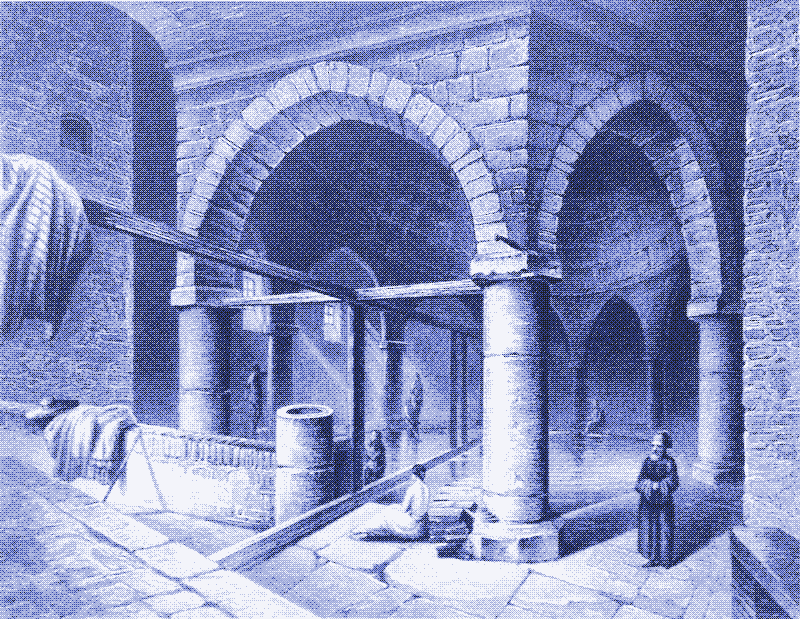
Northern Europe and Russia - never conquered by Roman or Islamic Empires - stuck to sweat and hot air baths. For example, public “banyas” existed in towns throughout Muscovy during the Middle Ages. 12 Asia also developed independent bathing cultures. For instance, in late medieval Japan, people shared private hot baths among families, neighbors, and friends for economic reasons. For these “cooperative baths” of mostly four to ten individuals, every bather brought a portion of firewood to heat the water. That practice evolved into larger public baths - “sento” - which experienced rapid growth from the fifteenth century onwards.2728

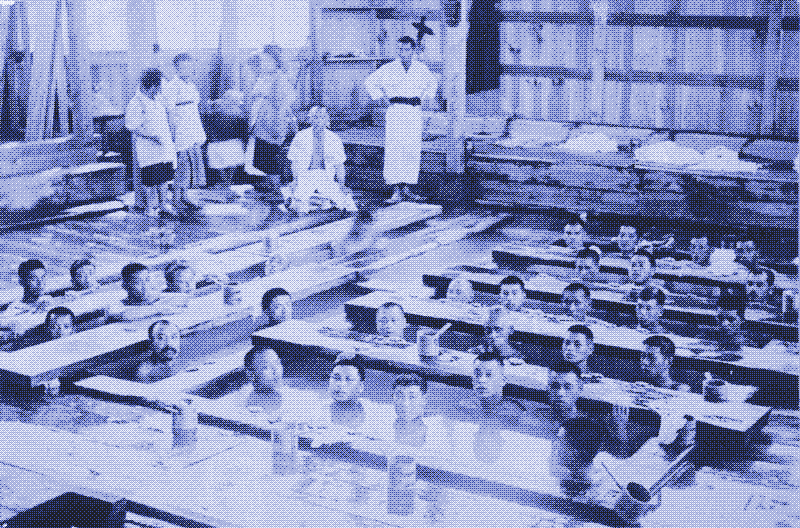
Bathing for Pleasure
Nowadays, sustainability advocates who promote shorter or less frequent showers implicitly regard bathing as a strictly utilitarian practice. However, for most of history, bathing was never just about hygiene. Apart from getting clean, people also visited public baths to relax, have fun, and socialize. Rather than a quick affair, the bathing process — no matter its form — often went on for hours. 1528
The Ancient Greeks sat together in individual bathtubs, having conversations, for which the space’s acoustics were optimally suited. 29 In Ancient Rome, public baths were places where people went almost daily to be seen, mingle, relax, gossip, dine, or play sports and study. Bathers accessed beauty treatments such as massages, shaving, hairdressing, and depilating. They celebrated parties and anniversaries and honored foreign guests. 1517192530
Rather than a quick affair, the bathing process — no matter its form — often went on for hours.
The medieval European bathhouse continued these traditions with less splendor but not necessarily with less revelry. In particular, medieval stews with wooden bathtubs were often a place of amusement that also furnished food, drink, music, and various types of bodily care. 23 In Japan, during the 16th century, public baths became places to gather and socialize, with large groups of people eating, drinking, and singing. 2728 River bathing, which continued around cities and in rural areas until the 20th century, was a kind of play in which swimming was a potential element. 31
At the same time, bathing was considered essential to prevent and cure diseases, following the Hippocratic ideas that people could maintain or restore the balance of bodily fluids by exposing the body to cold, hot, moist, or dry circumstances. The layout of preindustrial baths reflected these ideas, featuring pools and spaces of different temperatures. 1521

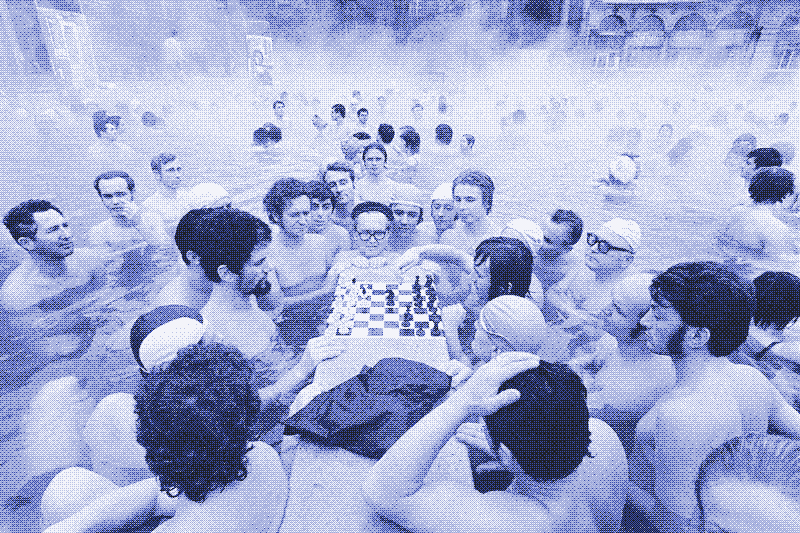
Communal Luxury
While these elements of pleasure, social interaction, and health continue today in mineral spas, there is a crucial difference with earlier bathing practices. The present-day spa is far too expensive to substitute for a private bathroom. In contrast, the historical public bathhouse was an egalitarian institution.
Roman public baths had no or low entrance fees and were open to everyone. There were no areas reserved for higher-ranking patrons. Combined with the splendid architecture and opulent decoration of the baths, this ensured that even the most humble servant would have a taste of luxury. 151719 These customs continued into the European Middle Ages and were shared by bathing cultures across the world. 23 For example, in Japan, the bathhouse aided in “slowly deconstructing the existing social hierarchy and created a new cultural flow between the elite and the commoners.” 2832
The only separation happened between men and women, and it was far from universal across space and time. They would either go to different bathhouses, occupy different sections, or share the same spaces at different times of the day or the week. 1215171923
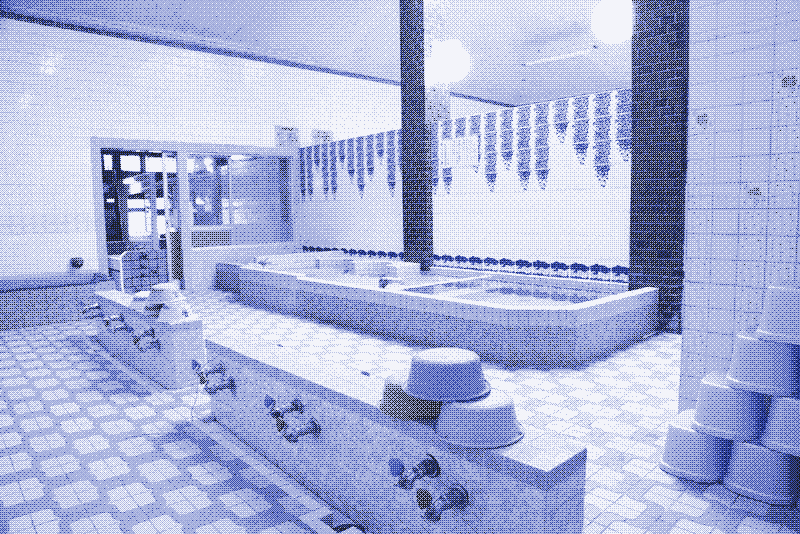
The Fuel Use of Roman Bathhouses
How sustainable was that communal luxury? Most research about the energy use of bathhouses concerns Ancient Roman baths. Historians have sometimes faulted the large bathhouses from the Empire for their wastefulness, arguing that their widespread use caused deforestation. 333435 However, in recent years, archeological research, thermal analysis, and heat transfer studies have made it increasingly clear that Ancient Roman bathhouses, in spite of their opulence, were remarkably energy-efficient buildings. 3633
The first reason was the hypocaust system. It consisted of one or more underground furnaces that distributed hot air under the floor and into the hollow walls (some baths had heated ceilings, too). Because of the large radiant surfaces, the spaces in the building could be heated at a lower temperature, saving energy. Although the water for the pools was reheated periodically in an insulated boiler close to the furnace, the heat in the floors and the walls helped to keep it warm for an extended period. 3633
A study of the Stabian Baths, one of the oldest surviving thermae, shows a fuel consumption of between 5 and 8 kg of firewood per hour, depending on the season. 3637 That corresponds to a wood supply of slightly more than 60 ash trees per year, which was unlikely to cause deforestation. 36 Firewood consumption was probably even lower because Roman baths routinely supplemented wood with other locally available fuels, often waste products: reeds, harvest by-products (olive pits, orchard trimmings, chaff), and animal wastes (dung and bones). 33
Many Roman baths were heated almost exclusively by solar energy on sunny days.
Following the same methodology, a study of a later bathing complex - the Forum Baths in Ostia - shows that the Romans continued improving their bathhouses’ energy efficiency. 3839 The Forum Baths were three times larger than the Stabian Baths - 923m2 versus 310m2 of heated spaces - but their calculated annual wood consumption is not even twice as high: roughly 100 trees per year. 3836 The newer bathhouse had thicker walls (two meters instead of one meter), as well as much larger glazed windows, which increased the share of solar radiation. 40 Earlier research has shown that the Forum baths were heated almost exclusively by solar energy on sunny days. 41
The studies above assume that the Romans heated their baths for 24 hours daily and only shut them down for maintenance. Roman bathhouses likely continued to be heated through the night, as it was more practical and energy-efficient. Many baths were open daily, and it could take a whole day to heat them from a cold state. In later centuries, medieval stews and hammams often used the heat or the ashes of the furnace to bake bread and other foods at night. 42 Hammams and medieval stews were less energy-efficient than Roman baths. Hammams had heated floors but no heated walls and few windows, while medieval stews often had none of these.

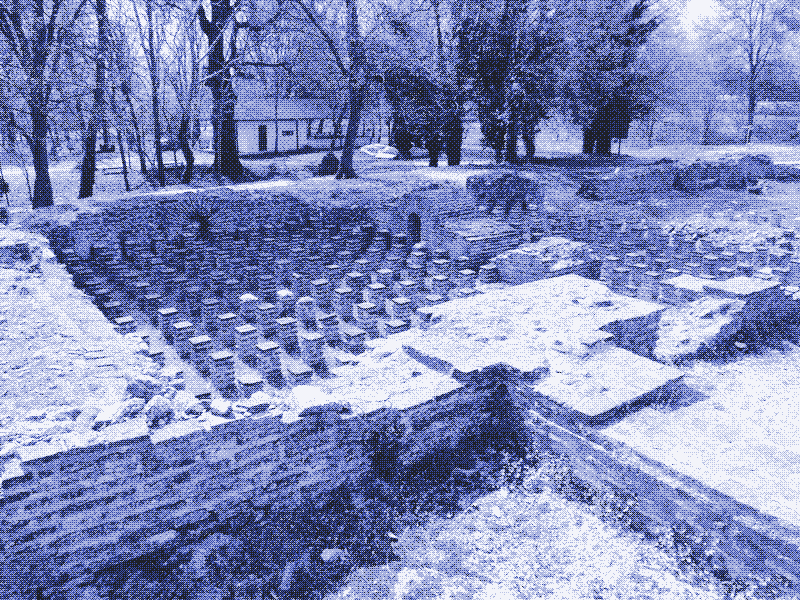

Roman Bathhouse Versus Private Shower
How does the energy use of the Roman bathhouse compare to that of the modern shower? Academic research does not provide an answer, but a quick calculation shows that the Roman bathing experience, which lasted for hours, was more energy-efficient than the present-day private shower, which lasts, on average, 9 minutes. The daily energy use of the Forum baths corresponds to the daily energy use of 557 showers. 43 While we don’t know how many people visited the Forum Baths daily, they likely surpassed that number: the baths could host up to 500 bathers simultaneously. 44
The Roman bathing experience, which lasted for hours, was more energy-efficient than the present-day private shower, which lasts, on average, 9 minutes.
Furthermore, in the calculation above, the energy use for the shower only concerns water heating, while the fuel use for the public baths also - and mainly - includes space heating. 36 For example, assuming that the water in the pools of the Stabian baths was changed only once per day, heating the water accounted for less than 10% of the total energy use, corresponding to the energy use of only 52 showers. The low energy use for water heating is partly explained by the excellent thermal insulation of the heated floors and walls, meaning that space and water heating cannot be separated. However, it is also because the Romans shared the water in pools, while every shower requires freshly heated water.
The Roman bathhouse also compares favorably to the typical backyard sauna, for which the fuel consumption hovers between 5 and 15kg of firewood per session. 45 Only sixteen such sauna sessions require as much fuel as the Stabian baths used daily. The sauna has no heated floor and walls. Furthermore, historically, it was often built partly underground to save fuel, but nowadays, it’s usually a badly insulated building standing in a cold climate.

The Public Baths of the Industrial Revolution
Bathing practices have changed quite a lot since Roman and late medieval times, particularly in most of the Western world. Few of us will have the time or even the need to linger in a bathhouse for several hours daily, and some of us may feel uncomfortable bathing in public. 30 However, a bathhouse can also take a form more in line with modern bathing habits. The public bathhouse of the Industrial Revolution demonstrates this.
In the nineteenth and early twentieth centuries, cities received large numbers of immigrants who came to work in factories. Most of these people were housed in overcrowded tenement buildings without running water, leading to unsanitary conditions. 46 Recurring epidemics and new medical insights led to a “gospel of cleanliness” that resulted in a new wave of public bathhouses across the Western world. Many of these baths only disappeared between the 1950s and 1980s.
The public hygiene movement began in England and peaked there in the 1840s. By 1896, more than 200 municipalities in Britain were maintaining public baths. The English bathhouse emulated the splendor of Roman baths in its architecture and decoration: it was “large, handsome, and costly.” 46 However, it did not copy the Ancient bathing customs. It now reserved different sections of the bathhouse for different social classes. Furthermore, while the pools still provided social interaction, the bathtubs were now placed in individual compartments. Finally, the modern bathhouse instituted maximum time limits for using the pool and the bathtubs. 464748

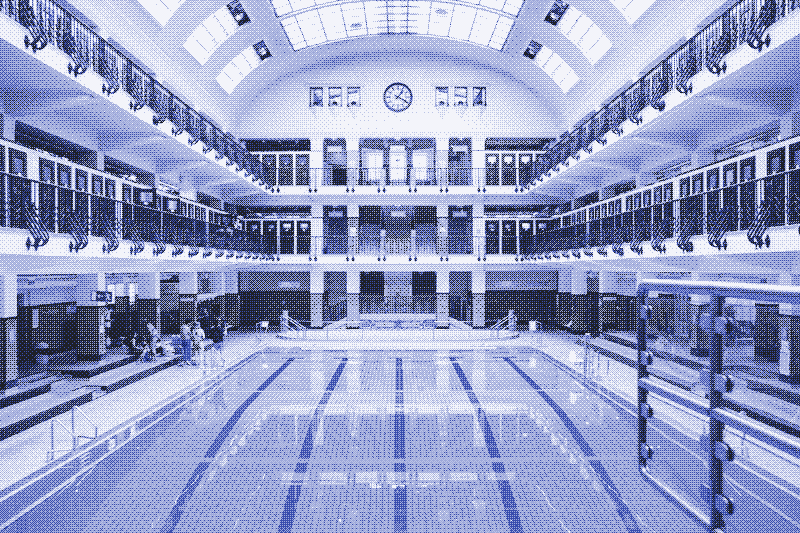
The Shower Bathhouse
Germany, the first to follow the British on the continent, also built monumental bathhouses. 49 However, in the 1880s, Berlin physician Oscar Lasser argued that the large baths were too costly to build in the necessary numbers. He proposed the introduction of smaller bathhouses with nothing but showers in individual compartments. Until then, the shower was only attached to a bathtub or used in barracks and prisons, where soldiers and inmates were showered with cold water. 484625
The shower bathhouse became the dominant public bath type in most of Western Europe and also in North America, where the sanitary reform movement took off in the 1890s. 5051 It cleared away the last vestiges of the Ancient bathing culture by ditching the pools and switching to a more practical architecture. For better or worse, the public bathhouse from the Industrial Revolution was the “antithesis of the preindustrial bathhouse.” 47 Although bathers still made use of communal infrastructure, there was no more space for pleasure, social interaction, public nakedness, and social mixing.
For better or worse, the public bathhouse from the Industrial Revolution was the antithesis of the preindustrial bathhouse.
As the higher social classes gradually gained access to their private water supply and bathrooms, the public bath became increasingly associated with poverty. Although shower bathhouses did not have separate sections for different social classes, they were mainly built in low-income neighborhoods, aimed at the poor only. Bathers were led to their shower cubicle by an attendant, who opened the tap, decided on the water temperature, and started a timer. People had at most 20 minutes to undress, shower, and dress again.4647 “The poor had to be clean but not enjoy it too much.” 46
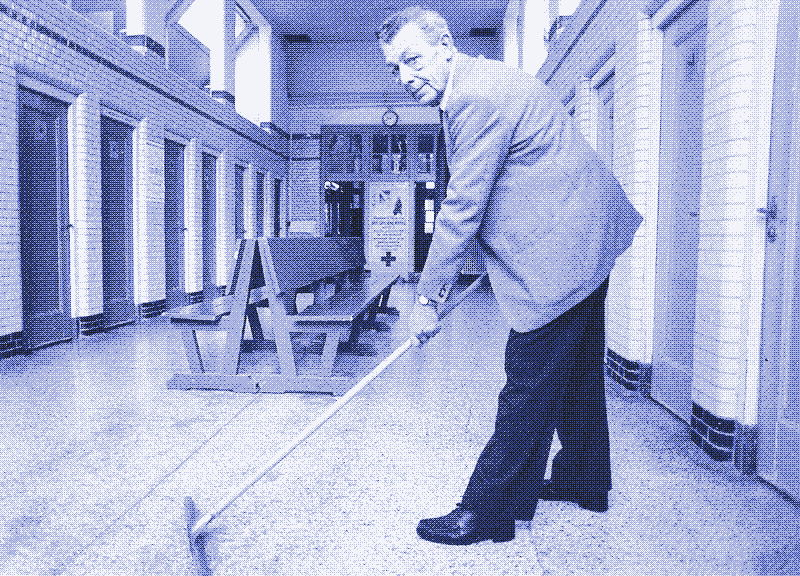
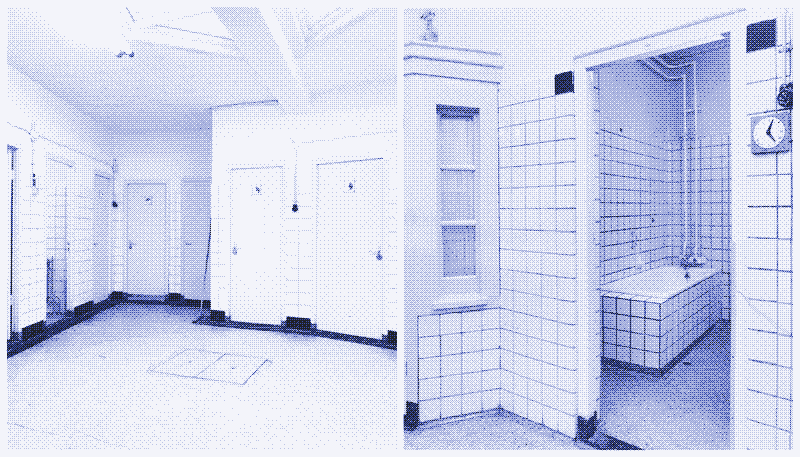
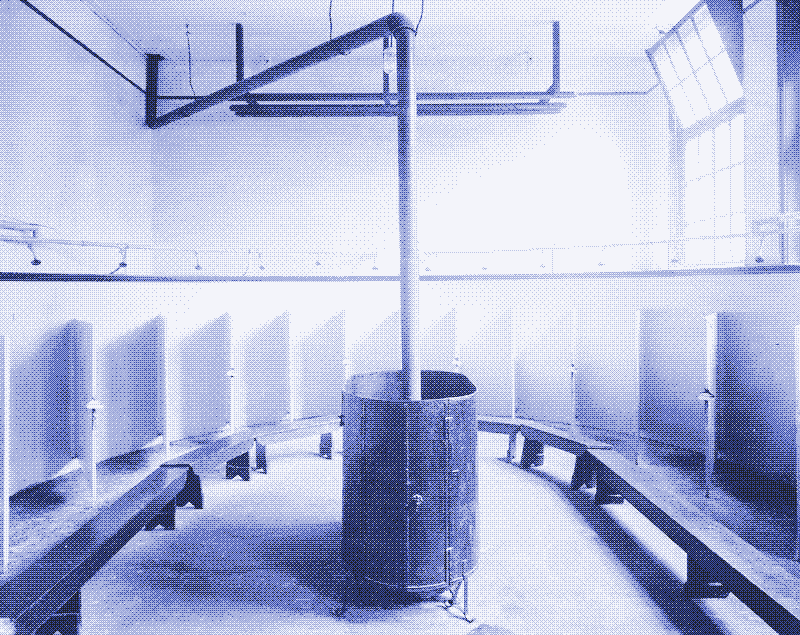
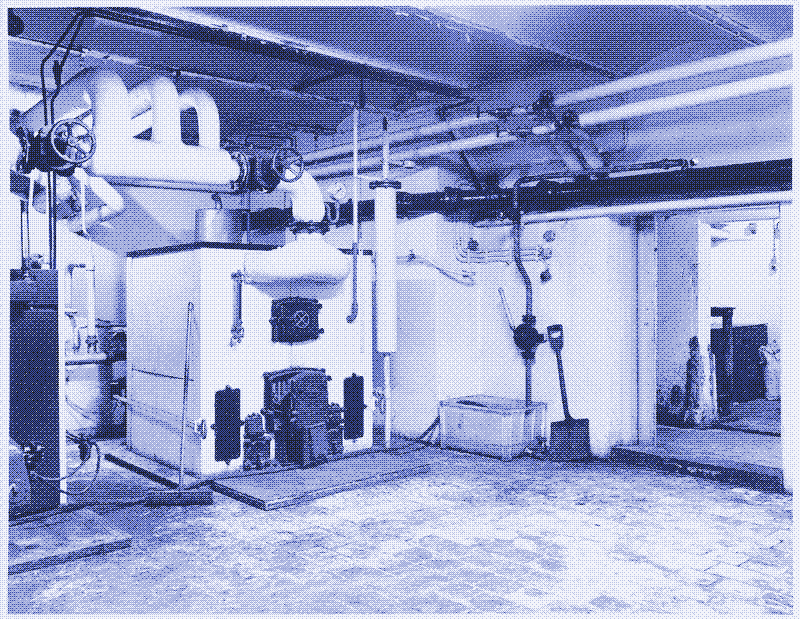
Bring Back the Public Bathhouse?
In Europe and North America, the public bathhouse disappeared once everyone got their private bathroom - although we still bathe together in sports centers and continue using communal bathrooms in hostels or campings. The public bathhouse survives elsewhere but is in decline almost everywhere. For example, Cairo had only eight hammams in 2000, compared to more than seventy at the beginning of the 19th century.5253 In 1968, greater Tokyo boasted 2,687 public bathhouses. In 2022, only 462 were left. 5455
Historically, the bathhouse was born out of the need for efficiency: bathing was too resource-intensive to organize individually. That is no longer the case thanks to the advance of central infrastructures - fossil fuels, electricity, water supply, sewers. However, in the context of the present environmental crisis, the resource efficiency of the public bathhouse has become relevant once again. It’s a solution that could reduce energy use relatively quickly without the need for new technologies or sacrificing comfort. Resilience is another argument for the bathhouse. 56
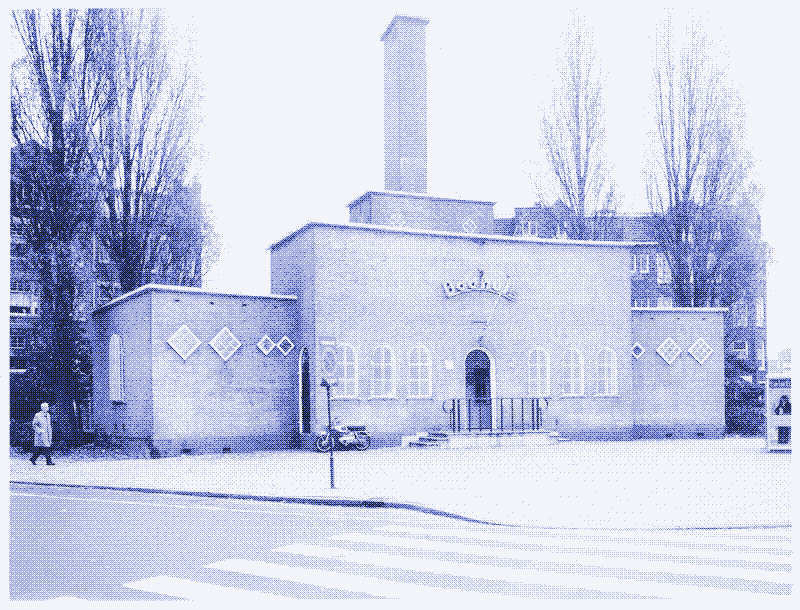

What Type of Public Bathhouse Do We Want?
The metamorphosis of the public bath in the 19th and 20th centuries, which also affected public baths outside the Western world, presents a challenge to anyone wanting to revive public bathing for sustainability. What type of bathhouse do we want? Of course, the Roman bath and the shower bathhouse are both extremes, and many intermediate forms are imaginable. Nevertheless, any designer of a future bathhouse will have to make decisions that are likely to be controversial.
For example, one could argue that the shower bathhouse not only fits modern bathing practices but also maximizes resource efficiency. That is especially true when the government, rather than the bather, controls shower duration and water temperature. In that way, the public bathhouse could become a technology to enforce frugality upon the whole population. However, to put it mildly, such an approach is unlikely to generate enthusiasm for reviving public bathhouses. Neither does it do much to improve social interaction. 57
Any designer of a future bathhouse will have to make decisions that are likely to be controversial.
Advocating for the return of the preindustrial public bathhouse, which centers around social interaction and communal luxury, may be more successful in luring people away from their private bathrooms, but it also runs into obstacles. The public bathhouse has faced resistance for 2,000 years, mostly because of conflicting views about health and morals. 58 For example, concerns about debauchery and prostitution - real and imagined - run throughout the history of the bathhouse in all cultures. 59 Separating males and females does not fully address those worries.

Any plea for reviving public baths will also have to deal with the fear of contagious disease. For example, a “lockdown” of society, as many governments applied during the coronavirus pandemic in 2020 and 2021, is incompatible with public bathhouses. Such a measure only works when everybody has a private bathroom. 60 The link between communal bathing and health is complex. Science has confirmed many of the health benefits of cold, hot, and steam baths and has also shown the importance of social interaction. However, bringing people together will always raise health risks, too.
How to Build a Low-tech Bathhouse?
There’s another distinction between bathhouses built before and after the Industrial Revolution: preindustrial baths worked with renewable fuels, while industrial baths ran on fossil fuels. Many modern bathhouses had an on-site coal power plant, which heated the space and the water and provided electricity for lighting. Fossil fuel-powered bathhouses are more energy efficient than fossil fuel-powered private bathrooms, but we can do better than that.
A large bathhouse heated by a hypocaust system and large windows is still hard to beat as a carbon neutral technology, at least based on sustainable wood production. 6162 However, biomass combustion creates air pollution, while we could also power a bathhouse with renewable energy sources that don’t have that problem. The most apparent solution for space and water heating is flat plate solar collectors in which the sun heats water. Heat-generating windmills are a low-tech alternative to solar thermal collectors in less sunny climates. 63 Other potential heat sources are geothermal energy and factory waste heat.
Fossil fuel-powered bathhouses are more energy efficient than fossil fuel-powered private bathrooms, but we can do better than that.
A solar or wind-powered bathhouse’s biggest drawback is its dependency on favorable weather conditions. To compensate for that, solar or wind power can be combined with thermal energy storage, such as insulated water tanks. Storing heat in a thermal mass for longer periods is much cheaper and more sustainable than storing electricity in chemical batteries. However, it requires space that only communal bathing can offer. Steam baths and saunas are more difficult to disconnect from biomass combustion, but some innovative examples exist. 64
Clustering bathing facilities in a shared infrastructure also creates sufficient space for a bathhouse to have extensive heat insulation (a decisive factor in energy consumption) and provide for its water supply (for example, by catching and storing rainwater) as well as wastewater treatment (for example through phytoremediation using plants).
Architects have applied some of these ideas in countries where public baths are still used. For example, in a mountain village in China, a community bathhouse for 5,000 people is largely off-the-grid, pumping up its water from a well, heating it with solar collectors, and filtering the run-off wastewater from the showers and the toilets in basins filled with bamboo plants. 65
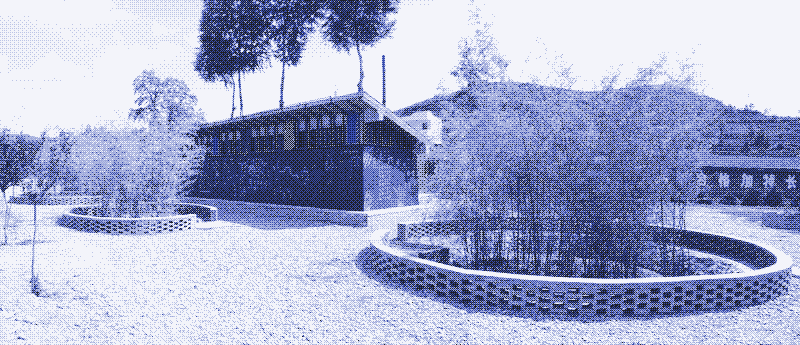
However, a public bathhouse also fits the more high-tech vision of a centralized energy infrastructure based on solar PV panels and wind turbines that provide electricity. In such a configuration, public bathhouses could absorb excess electricity during abundantly sunny or windy days. Rather than curtailing the electricity from surplus solar and wind power, we could use it to power electric heat pumps and store the heat in the thermal mass of public baths. 66 While this approach is less resource-efficient than off-grid bathhouses operating without electricity, it still beats a scenario in which a centralized renewable power grid supplies energy to many private bathrooms.
Kris De Decker
Many thanks to Jonas Görgen and Elizabeth Shove for their feedback on an earlier version of this article.
Marie Verdeil and Roel Roscam Abbing contributed to the selection of images.
Reactions
To make a comment, please send an e-mail to solar (at) lowtechmagazine (dot) com. Your e-mail address is not used for other purposes, and will be deleted after the comment is published. If you don’t want your real name to be published, sign the e-mail with the name you want to appear.
Reactions
Altair
Having grown up in industrial high tech modernity, a low(er) tech future is still something that I’ve only begrudgingly come to accept as the most likely one. I don’t see myself happily adapting to it. But this part of it is something I could definitely get on board with! We already spend millions of dollars and energy units building pools (or dredging artificial lakes, as was done in my community) just to have fun in them, so why not add the utilitarian benefit of bathing too?
I’ll say this though - despite what we already do in pool change rooms, spaces that promote public nudity will still be a hard sell in many places. And I’d like to see you better address low tech means of water filtration and purification. Bathing is different from swimming, and I have misgivings about washing my body in the same water that everyone else already did the same in (and we probably wouldn’t chlorinate such water for that reason). It’s like washing dishes in the same water that previously washed others. This would probably impact the choices of soap we could use too. Plus, if parents are gonna bring their young children along for a wash, someone WILL eventually pee in it, so the tots should definitely get a separate pool.
Heating the water is important, but it’s the easy part compared to all this IMO.
-Altair
Charmian
Hi Kris
Great article and a lot to appreciate in it.
A trend in Britain, and I presume elsewhere up north, these days is heading towards communal bathing in the form of the hot tub. These usually sit outside or on a covered veranda and seat around 4- 12 people. They are used communally – with people sitting in them for some time while they drink and talk.
Not specifically for cleansing reasons – more for enjoyment!
There is a design with a copper coil on the side in which wood can be placed to make a fossil fuel free heater for the water. But then a took a quick look online which showed me that there are masses of luxury hot tubs with built in wood stoves etc.
At one level it could be regarded as a return to communal bathing- but this is purely for the extravagant.
Thanks for all the work you do on low impact tech. We really need to get moving faster on this approach as climate change wreaks more havoc and minerals deplete rapidly.
All the best
Charmian
Sigrid Reymond
Interesting article. I think we still have some communal bathing in our society today, but it’s related to sports; gym bathrooms usually have communal showers, both in schools and private gyms. These places are also hotbeds of disease, like ringworm. Not to mention the gym equipment as well which has been found to have drug-resistant bacteria on it, such as wrestling mats that infected high school boys some years back.
Bringing back the public bathhouse might also conjure up 19th century images of prostitution as well. Our Victorian predecessors had good reason to move to private bathing and shut down the bath houses. We shouldn’t forget those lessons even as we look to improve our resource use practices.
JMCS
Hi Kris,
I just wanted to share with you an interesting bit of information: In Madrid, Spain, there are still two public bathhouses in use today.
They are quite notoriously aimed at “providing dignity” for the homeless and people living in poverty. I have visited and used both in different trips to Madrid, and both are examples of cleanliness and, indeed, dignity.
Talking with other users there, everyone was quite thankful for having this option. For 50 cents, you get access to a private and spacious shower room, for what felt like… 20 minutes?. Another user lamented (circa 2017, maybe?) that “it used to cost only 15 cents, but alas.”
https://www.revivemadrid.com/lugares-de-la-memoria/casa-de-banos (at the end of that article there’s a video that begins with the receptionist indeed telling someone “15 céntimos”)
Regards, and thanks for your site!
Angel
Hello Kris,
A lovely idea, but I won’t be visiting any public bathhouse any time soon. For many of us, the pandemic isn’t over. It’s contagious, airborne, and still killing and disabling people (including healthy people who have previously been infected and been ok) every day. Some ways to address the transmission of covid in bath houses can include rigorous HEPA filtration; required testing (using LAMP tests, for example, which are €10/test once you have the machine to read the results (another few hundred euro), and you can pool several people in one test); and maybe masks (I’ve read that they don’t work if they get wet, but I also read an article where someone tested several and went swimming with them. From memory, a regular Aura (~€1) worked nearly as long as an intentionally waterproof model). None of these are cheap by my standards. Not sure what you do about warts, foot fungus, and many other common bath house diseases.
Thanks, Angel
Kris De Decker
@ Altair
I could not review all the technical details, so the focus is on the heating. But yes, there are more issues to investigate. However, I don’t think those are unsolvable problems. After all, Japan is a sophisticated country where people share the same bathing water without significant health problems. They rinse their body with clean water afterwards. Although health risks can never be completely excluded. Early 2000s six people died in a Japanese bathhouse because of an infection.
Concerning young children, I think it makes sense to keep them in separate pools, which are more shallow so they won’t drown.
I don’t know if the bathhouse of the future will have showers, pools, both, or something in between. I left that open. It will surely depend on the region and the culture. As you write, public nudity is problematic in some places. However, in other places it is not. Historically, bathers were not always naked.
@ JMCS
Thanks for that link!
Meanwhile I discovered Vienna also has a shower bathhouse that is still operating: https://www.wien.gv.at/freizeit/baeder/uebersicht/saunabaeder/volksbad.html
@ Sigrid
I don’t think you read the article before you commented.
But, anyways, you refer to microbes in gyms. They are probably on public transport, too. As well as in hospitals, restaurants, supermarkets, hotels, bars, all places where people come together. Fear of contagious disease can get out of hand and ultimately lead to an isolated life. The safest society is that in which we all sit alone in a room for all of our lives.
Ben Johnson
Thanks Kris, great overview. Just wanted to mention an extant example: Porchester Spa in Westminster in London. In addition to being a beautiful building, it charges a reduced rate for residents (about £8 last time I was there) and has much more of a public bath vibe than a spa vibe. I’d love to see more of this kind of thing.
Simon
Hi Kris,
I just read your article on public bathing, including the comments where some commenters were wondering about sharing the same bathwater with other people.
I live in Japan, and here the tradition is to wash your body with soap at a shower stand (interestingly, sitting down on a small stool! some have standing showers as well), rinse the soap thoroughly, and then get into the bath once your body is clean - presumably this will solve a lot of the problems of “shared water”.
I don’t have a sento near me any more, but in my first year in Japan I lived in the mountains and there was a sento less than a minute’s walk from my house - in the winter I went there nearly every day, and it was joyous! I have a friend who lives a very simple life in the countryside, and he says in winter getting into the firewood-heated bath in his garden in the evening is the best part of his day.
The issue of airborn infectious diseases is interesting, because the solution is often “good ventilation” , which of course works in the opposite direction to “insulation”. I wonder what effect having good insulation on the bath and floors, whilst having free air flow in the room, would have on efficiency? I once visited an onsen in the mountains during winter, it was pretty wonderful to be outside looking at the snow-covered mountains whilst sitting in a hot bath.
Finally, the issue of nakedness and shared or separate gender bathing (which seems to ignore all but heterosexuality!) seems to me to be an emotional issue connected to shame we feel about our bodies and sexuality. Emotional issues are best addressed at an emotional level, which is a whole different topic, but in principle I see no reason why we humans cannot heal these emotional wounds and bath together naked both without shame and whilst keeping sex to be something enjoyed in private.
Thanks as always for your wonderful articles, yours is one of the few sites I recommend to people who are wanting to understand what “sustainability” really means.
Best wishes from Okinawa, Japan Simon
Simon
Kris,
I missed reading your reply in the comments where you said “the safest thing to do would be for us all to stay home forever” (or words to that effect).
I do agree - if we are going to oppose the idea of public bathhouses because people gather in crowds inside, then we would also have to oppose offices, factories, bars, theatres, dance clubs, any kind of classroom, and basically all indoor events of more than a handful of people…..
Ventilation might still be worth considering (in all the above!) but it’s hardly a reasonable risk-benefit analysis to become overly concerned with this issue to the exclusion of all others….
A lot of people had a lot of anxiety around COVID (myself included, for a while), refering back to my point about emotions: anxiety is an emotion, and is therefore best addressed as an emotion, using tools of emotional engagement (talking, meditation, spending time in nature, etc)
Cheers Simon
Sam Alder
For people discussing the sanitary aspects of shared air, I think we can look to the article linked below for answers. Heat can be retained in air by heat exchangers and condensers while still allowing for replacing the air of an entire room multiple times an hour. Standardizing this in every building would be a substantial undertaking but would more than make up for its cost because we already lose hundreds of hours of our lives per year to respiratory illness.
The Plan to Stop Every Respiratory Virus at Once https://www.theatlantic.com/health/archive/2021/09/coronavirus-pandemic-ventilation-rethinking-air/620000/
As many people are uncomfortable in shared public spaces, it would be highly sensible to design “private” bathrooms within the complex of the public baths. This would create a space where individuals could self select to use if they knew they have a communicable illness, and which could be sterilized with UV light between uses.
I continue to use Pandemic measures in my daily life. I have had one bout with Covid (after being vaccinated) and see no value in catching it or any strain of influenza or cold virus again. I think the 30% uptick in heart attack risk and similar increases in risk of a variety of other deadly and debilitating events is worth wearing a mask indoors and at large gatherings. I just wish we could all still be in it together and build the infrastructure to protect everyone instead of just protecting myself.
Dylan Koltz-Hale
I live in Minnesota where Finnish style sauna has been a consistent cultural factor. More and more sauna and cold plunge are growing in the public consciousness as a result of new media and increased research on the benefits. A whole wave of sauna and cold plunge businesses are popping up along with “trainings” for practitioners of these modalities.
In regards to the modalities my favorite protocol is starting with a Finnish sauna between 180 - 200F (in swimsuit, towel or nude - depending on the openness of company), taking a quick cold shower with soap with the purpose of cleaning oneself, then finishing in a cold tub 33 - 45F. In this way we combine the social aspects and hygienic aspects while avoiding sharing dirty water. This is also an energy efficient model as in many Western climates you don’t need to heat the water and the heated space is well insulated and relatively small - excess heat could be used to warm a deep winter greenhouse, cafe, etc.
I have been interested in organizing the community and local government to fund and build a public/accessible version of all of the exorbitantly expensive options ($60+ for a one-hour shared session).
Resources for those interested: Sweat: The Illustrated History and Description of the Finnish Sauna, Winter Swimming, Sauna: The Power of Deep Heat
Viva La Badhaus!